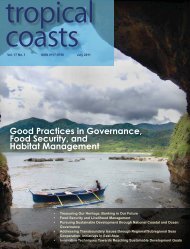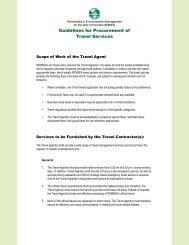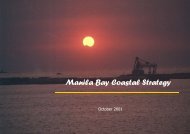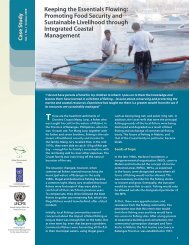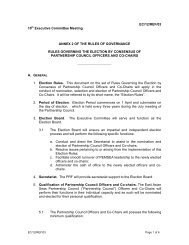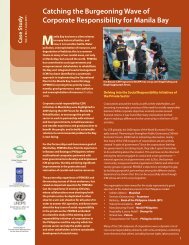Download PDF Copy - Pemsea
Download PDF Copy - Pemsea
Download PDF Copy - Pemsea
You also want an ePaper? Increase the reach of your titles
YUMPU automatically turns print PDFs into web optimized ePapers that Google loves.
S u s t a i n a b l e D e v e l o p m e n t A s p e c t s<br />
Natural and Man-made Hazard Prevention and Management<br />
016 Degree of vulnerability to disasters<br />
Description<br />
This indicator measures the degree to which populations<br />
are at risk of exposure to natural and man-made hazards,<br />
i.e., populations living within various multihazard zones.<br />
Rationale<br />
The greater the degree of potential exposure to natural and<br />
man-made hazards, the more that government and local<br />
communities should be prepared and must put in place<br />
mitigation measures for disasters. Identification of the<br />
levels of threat from various hazards can also help focus<br />
preparations on the most relevant types of threat.<br />
Data Requirements<br />
• Multihazard maps (landslides, storms, floods, etc.)<br />
• Number of people located in hazard-prone areas<br />
• Number of people who have relocated or moved away<br />
from hazard-prone areas<br />
Results<br />
An assessment of natural hazards in the Philippines<br />
estimates that there is a 20 percent probability that an<br />
earthquake exceeding Degree VIII intensity on the Modified<br />
Mercalli Scale will affect Batangas within 50 years. The<br />
assessment also estimates that there is a 10 percent<br />
probability that a storm of 210-249 km/h will strike the Lobo-<br />
San Juan area within the next 10 years while a storm of<br />
178-209 km/h will strike the rest of the Batangas coast within<br />
the next 10 years (Figure 9; Munich Reinsurance Company,<br />
2006).<br />
Although not in map form, an assessment of the level of<br />
vulnerability of each village in each municipality to various<br />
levels of flood and storm threats is available. Of 15 coastal<br />
municipalities in Batangas, 64 villages (approximately<br />
107,000 people — mainly in Nasugbu, Balayan, Lemery<br />
and Calaca) are categorized as “almost flooded as a result<br />
of heavy rains aggravated by high tide or rise in water<br />
level or nearby seas, lakes, rivers, etc.” Ninety-six villages<br />
(approximately 171,000 people — mainly in Nasugbu,<br />
Calatagan, Balayan, Bauan and San Juan) fall under “flooded<br />
60 State of the Coasts of Batangas Province



